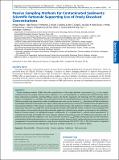| dc.contributor.author | Mayer, Philipp | |
| dc.contributor.author | Parkerton, Thomas F | |
| dc.contributor.author | Cargill, John G | |
| dc.contributor.author | Gan, Jay | |
| dc.contributor.author | Gouin, Todd | |
| dc.contributor.author | Hawthorne, Steven B | |
| dc.contributor.author | Helm, Paul | |
| dc.contributor.author | Witt, Gesine | |
| dc.contributor.author | You, Jing | |
| dc.contributor.author | Escher, Beate I | |
| dc.contributor.author | Adams, Rachel G | |
| dc.contributor.author | Gschwend, Philip M | |
| dc.date.accessioned | 2018-08-06T16:50:36Z | |
| dc.date.available | 2018-08-06T16:50:36Z | |
| dc.date.issued | 2013-11 | |
| dc.date.submitted | 2013-09 | |
| dc.identifier.issn | 15513777 | |
| dc.identifier.uri | http://hdl.handle.net/1721.1/117281 | |
| dc.description.abstract | Passive sampling methods (PSMs) allow the quantification of the freely dissolved concentration (Cfree) of an organic contaminant even in complex matrices such as sediments. Cfree is directly related to a contaminant's chemical activity, which drives spontaneous processes including diffusive uptake into benthic organisms and exchange with the overlying water column. Consequently, Cfree provides a more relevant dose metric than total sediment concentration. Recent developments in PSMs have significantly improved our ability to reliably measure even very low levels of Cfree. Application of PSMs in sediments is preferably conducted in the equilibrium regime, where freely dissolved concentrations in the sediment are well‐linked to the measured concentration in the sampler via analyte‐specific partition ratios. The equilibrium condition can then be assured by measuring a time series or a single time point using passive samplers with different surface to volume ratios. Sampling in the kinetic regime is also possible and generally involves the application of performance reference compounds for the calibration. Based on previous research on hydrophobic organic contaminants, it is concluded that Cfree allows a direct assessment of 1) contaminant exchange and equilibrium status between sediment and overlying water, 2) benthic bioaccumulation, and 3) potential toxicity to benthic organisms. Thus, the use of PSMs to measure Cfree provides an improved basis for the mechanistic understanding of fate and transport processes in sediments and has the potential to significantly improve risk assessment and management of contaminated sediments. | en_US |
| dc.description.sponsorship | Exxon Mobil Corporation | en_US |
| dc.description.sponsorship | Southern California Coastal Water Research Project | en_US |
| dc.description.sponsorship | Strategic Environmental Research and Development Program (U.S.) | en_US |
| dc.description.sponsorship | SETAC (Society) | en_US |
| dc.description.sponsorship | University of California, Riverside. Department of Environmental Sciences | en_US |
| dc.publisher | Wiley | en_US |
| dc.relation.isversionof | http://dx.doi.org/10.1002/IEAM.1508 | en_US |
| dc.rights | Creative Commons Attribution-NonCommercial 4.0 International | en_US |
| dc.rights.uri | http://creativecommons.org/licenses/by-nc/4.0/ | en_US |
| dc.source | Wiley | en_US |
| dc.title | Passive sampling methods for contaminated sediments: Scientific rationale supporting use of freely dissolved concentrations | en_US |
| dc.type | Article | en_US |
| dc.identifier.citation | Mayer, Philipp, Thomas F Parkerton, Rachel G Adams, John G Cargill, Jay Gan, Todd Gouin, Philip M Gschwend, et al. “Passive Sampling Methods for Contaminated Sediments: Scientific Rationale Supporting Use of Freely Dissolved Concentrations.” Integrated Environmental Assessment and Management 10, no. 2 (February 18, 2014): 197–209. | en_US |
| dc.contributor.department | Massachusetts Institute of Technology. Department of Civil and Environmental Engineering | en_US |
| dc.contributor.mitauthor | Adams, Rachel G | |
| dc.contributor.mitauthor | Gschwend, Philip M | |
| dc.relation.journal | Integrated Environmental Assessment and Management | en_US |
| dc.eprint.version | Final published version | en_US |
| dc.type.uri | http://purl.org/eprint/type/JournalArticle | en_US |
| eprint.status | http://purl.org/eprint/status/PeerReviewed | en_US |
| dc.date.updated | 2018-08-02T18:17:10Z | |
| dspace.orderedauthors | Mayer, Philipp; Parkerton, Thomas F; Adams, Rachel G; Cargill, John G; Gan, Jay; Gouin, Todd; Gschwend, Philip M; Hawthorne, Steven B; Helm, Paul; Witt, Gesine; You, Jing; Escher, Beate I | en_US |
| dspace.embargo.terms | N | en_US |
| dc.identifier.orcid | https://orcid.org/0000-0002-9497-4492 | |
| mit.license | PUBLISHER_CC | en_US |
